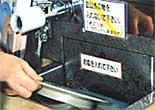Mmmm ... High-Tech Sushi
Back to Contents of Issue: March 2001
|
|
|
|
by Kyoko Fujimoto |
|
 EVER BEEN TO ONE OF THOSE sushi restaurants where the dishes pass before your eyes on little boats, or on a conveyor belt? In Japan this system is called Kaiten sushi, because kaiten means "circulate." Since the system's first appearance at the International Expo in Osaka in 1970, it has become probably the most widespread and affordable way to eat sushi. Kaiten sushi shops are everywhere in Japan, and nowadays are commonplace in other countries too. Many foreigners think that's what all sushi shops look like (indeed, traditional establishments are now in the minority). EVER BEEN TO ONE OF THOSE sushi restaurants where the dishes pass before your eyes on little boats, or on a conveyor belt? In Japan this system is called Kaiten sushi, because kaiten means "circulate." Since the system's first appearance at the International Expo in Osaka in 1970, it has become probably the most widespread and affordable way to eat sushi. Kaiten sushi shops are everywhere in Japan, and nowadays are commonplace in other countries too. Many foreigners think that's what all sushi shops look like (indeed, traditional establishments are now in the minority).
It's just ¥100-plate sushi, but the food is actually quite good. And sometimes they offer interesting menu choices, like sushi hamburger or sushi gyoza. If you're not a big wasabi fan, you don't have to ask them to make "non-wasabi" and wait forever -- just look for the specially colored plates, which indicate wasabi-free. Getting hungry? If you're in Tokyo, tough luck -- all the stores are located in and around Osaka. Kuro Sushi hopes to open its first shop in the Kanto area within the year.
|
|
Note: The function "email this page" is currently not supported for this page.


 One Osaka-based Kaiten sushi chain, Kura Sushi, is getting a lot of attention these days. After starting off as a take-out sushi shop in 1977, it saw the writing on the wall and took the kaiten route in 1984. Kura sells every plate for ¥100 (except for desserts, drinks, and some special menus), a method so popular the company has grown from 10 shops in 1995 to about 40 today. But what caught our attention was its patented, high-tech system for tracking how much you've eaten -- and owe.
One Osaka-based Kaiten sushi chain, Kura Sushi, is getting a lot of attention these days. After starting off as a take-out sushi shop in 1977, it saw the writing on the wall and took the kaiten route in 1984. Kura sells every plate for ¥100 (except for desserts, drinks, and some special menus), a method so popular the company has grown from 10 shops in 1995 to about 40 today. But what caught our attention was its patented, high-tech system for tracking how much you've eaten -- and owe.
 Implemented two years ago, the system works like this -- a QR (quick response) code on the plate tells the time when the sushi was put there by the chef. If the plate has circulated around for more than 55 minutes, it's automatically removed and the food is disposed of. The upshot? Customers don't have to worry about eating old sushi. Another cool thing is the plate counter: when you finish with a plate, you insert it into a slot. The system automatically counts how many items you've eaten. This way, big eaters like myself [editor's note: she's thin as a waif] don't have to be embarrassed by mountains of plates. A Kura Sushi spokesman says they now use the QR code component at every shop, the plate counter in about half. And of course they use the sushi robot -- quite common these days for making sushi quickly.
Implemented two years ago, the system works like this -- a QR (quick response) code on the plate tells the time when the sushi was put there by the chef. If the plate has circulated around for more than 55 minutes, it's automatically removed and the food is disposed of. The upshot? Customers don't have to worry about eating old sushi. Another cool thing is the plate counter: when you finish with a plate, you insert it into a slot. The system automatically counts how many items you've eaten. This way, big eaters like myself [editor's note: she's thin as a waif] don't have to be embarrassed by mountains of plates. A Kura Sushi spokesman says they now use the QR code component at every shop, the plate counter in about half. And of course they use the sushi robot -- quite common these days for making sushi quickly.



